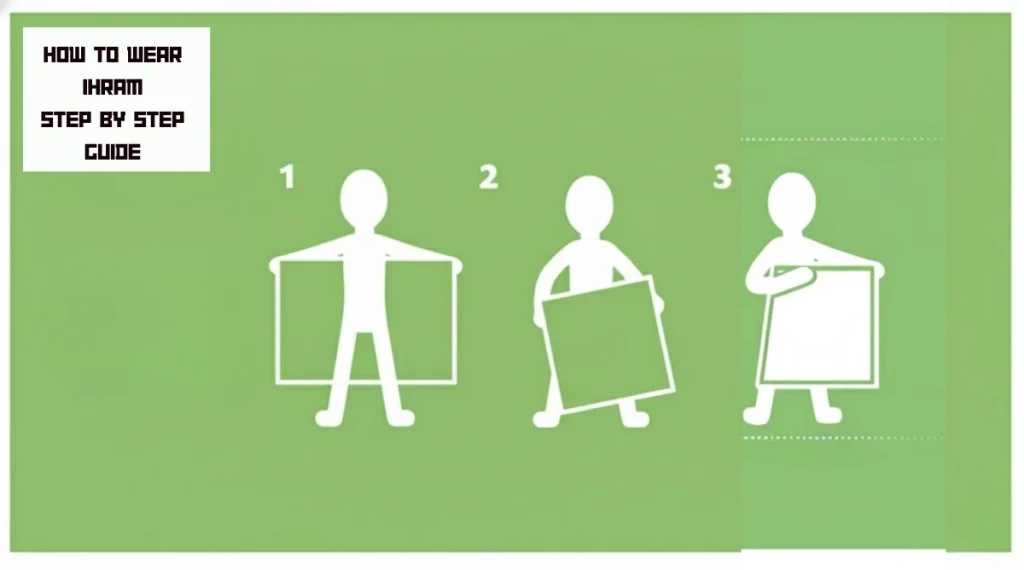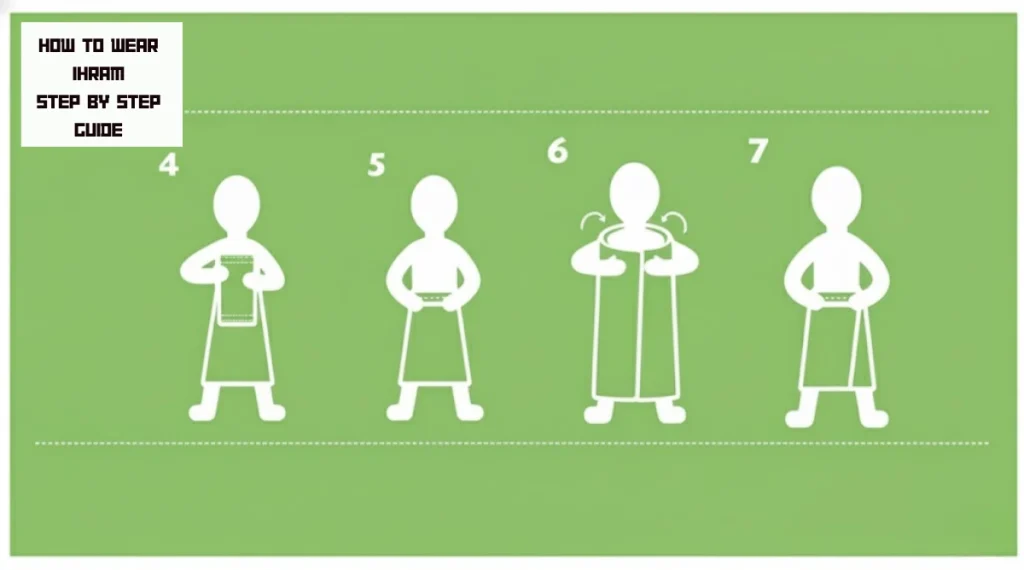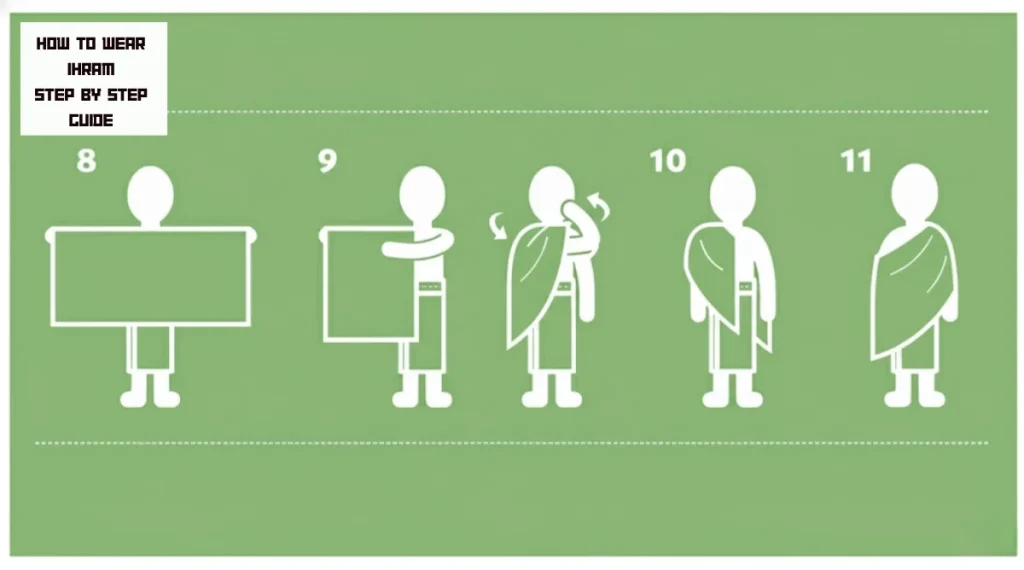How to Wear Ihram for Hajj & Umrah – Complete Step-by-Step Guide for Men, Women & Children

Performing Hajj or Umrah is one of the most significant spiritual journeys in a Muslim’s life. A key part of this sacred pilgrimage is entering the state of Ihram, a symbol of purity, humility, and devotion. Wearing Ihram is not just about clothing—it represents your spiritual commitment to Allah and readiness for worship.
Whether you’re a first-time pilgrim or need a refresher, this guide ensures you’re fully prepared for your sacred journey.
Quick Reference Guide
For Men: 2 white unstitched cloths (Izar + Rida) + open sandals + make intention + recite Talbiyah
For Women: Modest loose clothing + hijab (face uncovered) + flat shoes + make intention + recite Talbiyah
Before Miqat: Ghusl, trim nails, remove hair, apply unscented perfume (men only before wearing)
Prohibited: Perfume, stitched clothes (men), covering head (men), covering face (women), cutting nails/hair
What is Ihram?
Ihram is a sacred state of purity and devotion that every Muslim must enter before performing Hajj or Umrah. It consists of three interconnected aspects:
Spiritual Aspect
- Purification of the heart: Cleansing yourself from sins and worldly distractions
- Humility before Allah: Recognizing that all pilgrims are equal regardless of wealth, status, or nationality
- Complete devotion: Focusing entirely on worship and seeking Allah’s mercy
- Unity: Wearing similar simple garments symbolizes the equality of all Muslims
Physical Aspect
- For men: Two unstitched white cloths called Izar (lower garment) and Rida (upper garment)
- For women: Modest, loose-fitting clothing that covers the body except face and hands
- Cleanliness: The state requires ritual purification (Ghusl) and maintaining cleanliness throughout
Emotional and Intentional Aspect
- Niyyah (intention): Making a sincere intention in your heart to perform Hajj or Umrah
- Talbiyah: Reciting the sacred words “Labbayk Allahumma Labbayk” repeatedly
- Mindfulness: Being constantly aware of prohibited actions and maintaining proper conduct
Important: Ihram is NOT just clothing—it’s a complete state of being that affects your actions, speech, and thoughts throughout your pilgrimage.
When and Where to Wear Ihram
Pilgrims must enter the state of Ihram before crossing the Miqat, which are designated boundary points around Makkah. Crossing these boundaries without being in Ihram requires making expiation (dam).
Miqat Points for Pilgrims
| Miqat Name | Alternative Name | Best For | Distance from Makkah |
| Dhul Hulayfah | Abyar Ali | Pilgrims coming from/via Madinah | ~450 km |
| Al-Juhfah | Rabigh | Most international flights, Syria route | ~187 km |
| Qarn al-Manazil | Al-Sayl al-Kabir | Pilgrims from Najd, UAE, Oman, Qatar | ~94 km |
| Yalamlam | Al-Sadiah | Pilgrims from Yemen direction | ~54 km |
| Dhat Irq | — | Pilgrims from Iraq direction | ~94 km |
Timing Guidelines:
By Airplane:
- Airlines usually announce when you’re approaching Miqat (30-45 minutes before)
- Wear Ihram and make intention 30-40 minutes before the announcement
- PIA and Saudi Airlines typically announce in Urdu and English
- Better to wear early than risk crossing Miqat unprepared
By Road (Bus/Car):
- Stop at the designated Miqat rest area
- Use facilities provided for Ghusl and changing
- Make intention before resuming journey
From Home:
- Some pilgrims prefer wearing Ihram at home or at the airport (without restrictions applying until Miqat)
- Make the formal intention (Niyyah) and begin restrictions only at or before Miqat
Warning: Crossing Miqat without Ihram requires you to return to Miqat to enter Ihram properly, or you must offer Damm (sacrifice). Don’t risk this—prepare in advance!
Preparation Before Wearing Ihram
Proper preparation is essential for entering Ihram correctly. Follow these steps in order:
Step 1: Perform Ghusl (Ritual Purification Bath)
- Take a complete bath with the intention of purification for Ihram
- Wash your entire body thoroughly, including private parts
- Women in menstruation or post-childbirth bleeding should also perform Ghusl
- This is Sunnah and highly recommended, though wudu (ablution) is sufficient if Ghusl isn’t possible
Step 2: Grooming
- Trim your nails (hands and feet)
- Remove unwanted body hair (underarms, pubic area)
- Men: Trim or shave beard if desired (you won’t be able to after entering Ihram)
- Women: Remove facial hair if needed
- Do these BEFORE wearing Ihram, as they’re prohibited afterward
Step 3: Apply Fragrance (Men Only)
- Apply unscented or lightly scented attar/perfume to your body (NOT to Ihram garments)
- Apply to hair, beard, chest, and body
- This is Sunnah and recommended before wearing Ihram
- Once in Ihram, you cannot apply or reapply any fragrance
- Women: Do NOT apply any perfume or scented products
Step 4: Clothing Underneath
For Men:
- Only Ihram is Allowed
- Avoid any stitched Clothing
- Keep it simple and loose
For Women:
- Choose loose, comfortable clothing that won’t show through outer garments
- Avoid tight or revealing clothing
Step 5: Mental and Spiritual Preparation
- Make sincere Tawbah (repentance) for past sins
- Prepare your heart with the intention of devotion
- Consider praying 2 Rakah Nafl (optional prayer) for Ihram if time permits
- Review prohibited actions in Ihram
- Mentally prepare to focus on worship and avoid worldly distractions
Pro Tip: Carry wet wipes, unscented soap, and a small towel in your hand luggage for last-minute preparation on the plane or at rest stops.
How to Wear Ihram for Men – Complete Step-by-Step Guide
Required Items Checklist
Izar (lower garment) – white unstitched cloth, approximately 2m x 1.25m
Rida (upper garment) – white unstitched cloth, approximately 2m x 1.25m
Ihram belt (optional but highly recommended for security)
Open-toed sandals or flip-flops (top of feet must be visible)
Small pouch or belt bag for money, documents, phone (attached to belt)
Step 1 – Wrapping the Izar (Lower Garment)
The Izar wraps around your waist and covers from navel to below the ankles.

Method:
- Hold the cloth behind your back at waist level, ensuring equal length on both sides
- The cloth should cover from your navel to your ankles (not dragging on the ground)
- Wrap the right side across your front to your left hip
- Wrap the left side over the right side, covering your front completely
- Secure the top edge by rolling or folding it inward several times (3-4 rolls)
- Optional: Use an Ihram belt (simple cloth or elastic belt) around your waist to secure it
Common Securing Methods:
- Rolling technique: Roll the top edge tightly inward 3-4 times
- Tucking technique: Tuck the corner into the rolled edge
- Belt method: Wrap a simple cloth belt around the rolled edge (most secure)
Important Points:
- The cloth must cover from navel to ankles – no exposed knees or thighs
- It should be tight enough not to slip but loose enough to walk and sit comfortably
- DO NOT use safety pins, buttons, or any fasteners
- Practice at home before your journey – it takes a few tries to get it right!
Common Mistake: Wrapping the Izar too loosely, causing it to slip while walking or during Tawaf. Practice the rolling and tucking technique thoroughly.
Step 2 – Draping the Rida (Upper Garment)
The Rida covers your upper body, both shoulders, chest, and back.

Method:
- Spread the cloth horizontally behind your shoulders like a shawl
- Cover both shoulders completely – the cloth should drape evenly
- Bring one end across your chest and over the opposite shoulder
- Let the other end hang freely or tuck it slightly for security
- Adjust for coverage – ensure your chest, back, and both shoulders are covered
- The cloth should reach approximately to your knees when draped properly
Tips for Security:
- Keep readjusting throughout the journey as the Rida can slip
- During Tawaf and Sa’i, you’ll need to secure it more carefully due to movement
- Some pilgrims tuck one corner into the Izar belt for extra security
Important:
- Both shoulders MUST be covered except during Tawaf (when performing Idtiba)
- If the Rida slips off, simply re-drape it – no penalty
- Keep the cloth clean and modest at all times
Step – Idtiba (During Tawaf Only)
Idtiba is the Sunnah practice of exposing the right shoulder during Tawaf al-Qudum (arrival Tawaf) and Tawaf al-Umrah.

How to Perform Idtiba:
- Take the Rida from your right shoulder
- Bring it under your right armpit
- Drape it over your left shoulder
- Your right shoulder is now exposed, left shoulder covered
- After completing Tawaf, cover both shoulders again
When to Do Idtiba:
- During Tawaf al-Umrah (Umrah)
- During Tawaf al-Qudum (arrival Tawaf for Hajj)
- NOT during Sa’i
- NOT during Tawaf al-Ifadah or Tawaf al-Wida
Step 4 – Footwear and Accessories
Footwear Rules:
- Allowed: Open sandals, flip-flops, slippers (top of feet visible, heel exposed)
- Prohibited: Closed shoes, socks covering ankles, shoes covering top of feet
- The back of the heel and top of the foot must be visible
Accessories – What’s Allowed:
- Watch: Permitted (keep it simple)
- Ring: Allowed (wedding ring, simple rings)
- Glasses/Sunglasses: Permitted
- Belt/Pouch: For money, phone, documents (must be simple)
- Umbrella: Allowed for sun protection
- Socks: Not allowed for men
- Hat/Cap: Not allowed (head must remain uncovered)
Pro Tip: Invest in good quality, comfortable sandals with grip. You’ll be walking A LOT. Break them in before your journey to avoid blisters.
Step 5 – Making Intention (Niyyah) and Reciting Talbiyah
Once you’re dressed in Ihram and approaching or at the Miqat, you must make your intention and begin reciting Talbiyah.
Making Niyyah (Intention):
The intention is made in the heart, but you can say it verbally:
For Umrah:
- Arabic: نَوَيْتُ الْعُمْرَةَ وَأَحْرَمْتُ بِهَا لِلهِ تَعَالَى
- Transliteration: Nawaitul Umrata wa ahramtu biha lillahi ta’ala
- Translation: “I intend to perform Umrah and enter Ihram for the sake of Allah”
For Hajj (Ifrad):
- Arabic: نَوَيْتُ الْحَجَّ وَأَحْرَمْتُ بِهِ لِلهِ تَعَالَى
- Transliteration: Nawaitul Hajja wa ahramtu bihi lillahi ta’ala
- Translation: “I intend to perform Hajj and enter Ihram for the sake of Allah”
Reciting the Talbiyah:
After making intention, immediately begin reciting the Talbiyah loudly (men) or softly (women):
Arabic: لَبَّيْكَ اللَّهُمَّ لَبَّيْكَ، لَبَّيْكَ لَا شَرِيكَ لَكَ لَبَّيْكَ إِنَّ الْحَمْدَ وَالنِّعْمَةَ لَكَ وَالْمُلْكَ، لَا شَرِيكَ لَكَ
Transliteration: Labbayka Allāhumma labbayk, labbayka lā sharīka laka labbayk Inna al-ḥamda wa n-ni’mata laka wa l-mulk, lā sharīka lak
Translation: “Here I am, O Allah, here I am. Here I am, You have no partner, here I am. Surely all praise, blessings, and sovereignty belong to You. You have no partner.”
When to Recite:
- Start immediately after making Niyyah at Miqat
- Continue frequently throughout your journey to Makkah
- Recite during Tawaf and Sa’i
- Stop when you begin Tawaf (some scholars say continue, most say stop)
- Men should recite loudly; women should recite softly
Pro Tip: Memorize the Talbiyah before your journey. Recite it with humility and emotion—it’s your response to Allah’s invitation. Many pilgrims find this moment deeply moving.
Ihram for Women – Complete Guide
Women’s Ihram is different from men’s in clothing requirements but follows the same spiritual principles and restrictions.
Clothing Requirements for Women
General Rules:
- Loose, modest clothing covering entire body except face and hands
- Preferably white, black, or neutral colors
- Long-sleeved dress, abaya, or loose pants with long tunic
- Hijab covering hair and neck completely
- Flat shoes or sandals
- Face covering (niqab) is prohibited in Ihram
- Gloves are prohibited
- Tight, transparent, or revealing clothing
- Bright colors or attention-grabbing patterns (discouraged)
- Perfume, makeup, or jewelry (except simple wedding ring)
Specific Guidelines:
- Your clothing can be stitched (unlike men’s Ihram)
- Choose breathable, comfortable fabric (you’ll wear it for hours/days)
- Consider the Saudi heat—lightweight cotton or linen works best
- Layers are helpful as masjid air conditioning can be very cold
Step-by-Step Guide for Women
Step 1: Preparation
- Perform Ghusl (ritual bath)
- Trim nails and remove unwanted hair
- Do NOT apply any perfume, scented lotion, or deodorant
Step 2: Dressing
- Put on your chosen modest outfit (abaya, loose dress, or tunic with pants)
- Ensure clothing covers from neck to ankles and wrists
- Put on hijab covering all hair and neck
- Keep face and hands completely visible and uncovered
- Wear comfortable flat shoes or sandals
Step 3: Making Intention
- At or before Miqat, make sincere intention for Umrah or Hajj in your heart
- You may verbally say: “Nawaitul Umrata wa ahramtu biha lillahi ta’ala” (I intend Umrah and enter Ihram for Allah’s sake)
Step 4: Reciting Talbiyah
- Begin reciting Talbiyah softly (women should not raise their voices)
- Continue throughout your journey to Makkah
- Recite frequently with humility and devotion
Important Points for Women:
Face Covering:
- Your face MUST remain uncovered during Ihram
- If you normally wear niqab, you must remove it
- Exception: If non-mahram men are very close (crowded areas), you may drape your hijab forward slightly without it touching your face
- Use an umbrella or face shield that doesn’t touch the face for extra privacy
Menstruation and Post-Childbirth Bleeding:
- Women in menstruation (Haid) or post-childbirth bleeding (Nifas) CAN enter Ihram
- You should still perform Ghusl and wear Ihram
- You can make intention and recite Talbiyah
- You CANNOT perform Tawaf until you’re pure
- You CAN stay in Mina, Arafat, Muzdalifah during Hajj
- Consult with your group guide for specific guidance
Practical Tips:
- Bring extra hijabs in case one gets dirty
- Safety pins are very useful for securing hijab
- Carry unscented wipes for freshness
- Consider moisture-wicking fabric for comfort in Saudi heat
Pro Tip for Sisters: Practice wearing your Ihram outfit at home for several hours to ensure it’s comfortable and modest during all movements—sitting, walking, bending. Adjust before your journey.
Ihram for Children
Children’s Ihram follows the same rules as adults, adapted for their age and size.
Boys (Pre-Puberty)
Clothing:
- Two-piece white unstitched garments like adult men (Izar and Rida)
- Can use smaller sized Ihram cloth (available in Islamic shops)
- Optional: Child-sized Ihram belt for extra security
- Open sandals or flip-flops
Practical Tips:
- Use a secure belt—children are very active and the Izar can slip easily
- Some parents use safety pins for young children (scholars differ; generally allowed for children)
- Make sure the cloth isn’t too long to avoid tripping
- Explain to the child what Ihram means and why it’s special
Intention and Talbiyah:
- Parents make the intention on behalf of young children
- Teach older children to recite Talbiyah
- Children above 7 should try to follow Ihram rules
- Be lenient—children aren’t held accountable until puberty
Girls (Pre-Puberty)
Clothing:
- Loose dress or abaya (child-sized)
- Hijab covering hair
- Face and hands exposed (same as adult women)
- Comfortable flat shoes or sandals
Practical Tips:
- Choose soft, breathable fabrics for comfort
- Simple cotton abayas work best for children
- Avoid fancy or decorated clothing
- Make sure hijab is secure but not too tight
Intention and Talbiyah:
- Parents make intention for young girls
- Encourage older girls to recite Talbiyah softly
- Teach them about modesty and Ihram rules
- Be patient and make it a positive learning experience
General Guidelines for Children:
Age Requirements:
- Children are not obligated to perform Hajj/Umrah until puberty
- However, bringing them earns reward for parents
- Their Hajj/Umrah is valid but doesn’t fulfill their future obligation
Prohibited Actions:
- Teach children to avoid: cutting nails/hair, using perfume, harming animals
- Be understanding if young children accidentally break rules
- No expiation required for pre-puberty children
Comfort and Safety:
- Keep children hydrated
- Bring snacks (unscented)
- Have them wear comfortable, well-fitting footwear
- Keep close supervision in crowded areas
- Consider a small backpack with essentials
Parent Tip: Make Ihram exciting for children by explaining its significance in simple terms. Involve them in preparation, teach them duas, and create positive memories of their first pilgrimage.
Wearing Ihram on an Airplane
Most pilgrims will enter Ihram while flying to Jeddah or Madinah. Here’s exactly how to manage it:
Before Boarding
At Home:
- Perform Ghusl and complete all grooming
- Men can apply unscented perfume to body (not to Ihram garments)
- Pack your Ihram garments in hand luggage (easily accessible)
- Wear comfortable travel clothes for now
At the Airport:
- Some men prefer to wear Ihram at the airport before boarding
- This is permissible but remember: restrictions don’t apply until you make intention at Miqat
- Women can wear their Ihram outfit or change on the plane
On the Plane
Timing – Critical:
- Airlines usually announce Miqat 30-45 minutes before crossing it
- Change into Ihram 45-60 minutes before the announcement to avoid rush
- Better to be ready early than miss the Miqat
Step-by-Step for Men:
- Go to the airplane bathroom with your Ihram bundle
- Remove your shirt and pants
- Wrap the Izar first (follow wrapping instructions from Section 4)
- Use the belt method for extra security on the plane
- Make sure it’s secure before leaving the bathroom
- Drape the Rida over both shoulders
- Return to your seat
- Wait for Miqat announcement or designated time
- Make Niyyah (intention) when pilot announces Miqat or when you reach the point
- Begin reciting Talbiyah loudly (but respectfully—you’re on a plane)
Step-by-Step for Women:
- If not already wearing Ihram outfit, change in the bathroom
- Ensure hijab is properly covering hair and neck
- Remove any niqab or face covering
- Remove any perfume or scented lotion
- Return to seat
- Wait for Miqat announcement
- Make Niyyah when Miqat is reached
- Recite Talbiyah softly
Practical Airplane Tips:
Bathroom Logistics:
- Airplane bathrooms are small—practice wrapping Ihram at home
- Bring a small clip or belt to secure Izar temporarily
- Change during less busy times (not during meal service)
Group Travel:
- Coordinate with family/group members
- Men can help each other secure Ihram
- Take turns using bathroom if traveling in a group
After Changing:
- Store your regular clothes in carry-on bag
- Keep Ihram neat and modest
- Sit carefully to avoid Izar slipping
What to Keep Handy:
- Ihram belt
- Small pouch for passport, boarding pass, money
- Unscented wipes
- Water bottle (for wudu)
- Prayer mat (for Salah)
Airline-Specific Notes:
- PIA (Pakistan International Airlines): Usually announces in Urdu and English
- Saudi Airlines: Very experienced with Hajj/Umrah passengers, clear announcements
- Emirates/Etihad: Crew usually accommodates pilgrims changing into Ihram
What If You Miss the Miqat?
If you accidentally cross Miqat without Ihram:
- Don’t panic—it can be corrected
- Make intention immediately when you realize
- You’ll need to offer Dam (sacrifice) as expiation
- Consult with your Umrah group guide or local scholars in Makkah
- Continue with your pilgrimage—it’s still valid
Flight Tip: Set an alarm or reminder 90 minutes before scheduled Miqat crossing. Airlines sometimes get busy and announcements may be unclear. Better to be proactive!
Common Mistakes Pilgrims Make in Ihram
Avoid these frequent errors to ensure your Ihram is correct and valid:
Mistake #1: Wearing Stitched Clothing (Men)
Error: Wearing underwear, undershirts, or stitched garments under Ihram Correct: Only unstitched garments; if wearing anything underneath, it must be loose and unstitched Note: Scholars differ on underwear—when in doubt, avoid it
Mistake #2: Using Scented Products
Error: Using scented soap, deodorant, lotion, or hair oil after entering Ihram Correct: Only use unscented products once in Ihram; apply perfume only BEFORE wearing Ihram (men) Common culprits: Scented hand sanitizer, perfumed tissues, scented laundry detergent on Ihram
Mistake #3: Covering the Face (Women)
Error: Wearing niqab or face veil during Ihram Correct: Face must remain completely uncovered; use umbrella or drape hijab forward without touching face if needed
Mistake #4: Covering the Head (Men)
Error: Wearing cap, turban, hat, or hoodie Correct: Head must remain completely bare at all times during Ihram Exception: Using umbrella for shade is allowed
Mistake #5: Not Making Niyyah at Correct Time
Error: Making intention too early (at home) or too late (after Miqat) Correct: Make intention exactly at or just before reaching Miqat; restrictions begin only after Niyyah
Mistake #6: Loose Izar Not Secured Properly
Error: Wrapping Izar too loosely, causing it to slip and expose private parts Correct: Practice wrapping technique; use belt; roll the top edge multiple times for security
Mistake #7: Not Reciting Talbiyah Frequently
Error: Reciting Talbiyah only once at the beginning Correct: Recite it constantly throughout your journey to Makkah—this is the spirit of Ihram
Mistake #8: Scratching or Pulling Hair
Error: Unconsciously scratching scalp vigorously or combing hair, causing hair to fall Correct: Be gentle; if scratching, do it lightly without pulling hair out
Mistake #9: Trimming Nails or Cutting Hair
Error: Cutting nails or removing any hair from the body while in Ihram Correct: Do all grooming BEFORE wearing Ihram; avoid touching or removing any hair during Ihram
Mistake #10: Engaging in Arguments or Disputes
Error: Fighting, arguing, using foul language, or behaving rudely Correct: Maintain patience, kindness, and humility—this is as important as physical rules
Mistake #11: Using Regular Soap During Wudu
Error: Using scented soap or shampoo while making wudu in Ihram Correct: Use only unscented soap or plain water
Mistake #12: Killing Insects or Animals
Error: Swatting mosquitoes, killing ants, or harming any creature Correct: Avoid harming any living creature; you can gently shoo them away or use mosquito nets
Mistake #13: Not Preparing Ihram Properly at Home
Error: First time wearing Ihram is on the plane in a tiny bathroom Correct: Practice wrapping Izar and Rida at home multiple times before travel
Mistake #14: Wearing Socks (Men)
Error: Wearing regular socks covering ankles Correct: Feet must be in open sandals with top of feet and heels visible
Mistake #15: Not Keeping Ihram Clean
Error: Allowing Ihram to get dirty, muddy, or stained and not washing it Correct: Keep Ihram as clean as possible; if it gets dirty, wash with unscented soap
Important: If you accidentally break an Ihram rule, don’t panic. Most violations require Fidyah (expiation). Consult your guide or local scholars. Your Hajj/Umrah is still valid—just make expiation and continue with devotion.
Prohibited Actions While in Ihram
While in the state of Ihram, certain actions are strictly forbidden. Violating these rules may require expiation (Fidyah or Dam).
Complete List of Prohibitions:
1. Using Perfume or Scented Products
- Applying perfume, cologne, attar to body or clothes
- Using scented soap, shampoo, deodorant, lotion
- Applying scented oils or creams
- Eating perfumed food (some scholars allow)
- Allowed: Unscented products, plain water
2. Cutting or Removing Hair
- Cutting, shaving, trimming, or plucking any hair from head or body
- Scratching head vigorously if it causes hair to fall
- Using combs that pull out hair
- Allowed: Gentle washing, light scratching without removing hair
3. Trimming or Cutting Nails
- Cutting nails from hands or feet
- Trimming or filing nails
- Allowed: If nail breaks accidentally, no penalty
4. Covering the Head (Men Only)
- Wearing cap, hat, turban, or anything covering head
- Placing cloth or towel on head
- Covering head with part of Rida
- Allowed: Using umbrella, sitting under shade, carrying things on head
5. Covering the Face (Women Only)
- Wearing niqab or face veil touching the face
- Tying anything across the face
- Allowed: Draping hijab forward without touching face, using umbrella for privacy
- for privacy
6. Wearing Stitched Garments (Men Only)
Not Allowed
- Wearing shirts, pants, underwear, or any stitched clothing
- Wearing socks covering ankles
- Wearing closed shoes
- Allowed: Ihram belt, wearing sandals, carrying stitched items (bag, backpack)
7. Sexual Relations and Physical Intimacy
Not Allowed
- Sexual intercourse (major violation—requires major expiation)
- Kissing, touching with desire, or any intimate physical contact
- Discussing sexual matters or engaging in inappropriate conversation
- Allowed: Holding hands with spouse without desire, normal conversation
8. Marriage Contract
Not Allowed
- Conducting or attending marriage ceremony
- Proposing marriage
- Acting as witness for marriage contract
- Allowed: Existing marriage remains valid
9. Hunting or Harming Animals
Not Allowed
- Hunting, killing, or harming wild animals or birds
- Pointing out game animals to others for hunting
- Assisting others in hunting
- Allowed: Killing harmful creatures (snakes, scorpions, rats, crows)
- Allowed: Eating meat hunted by non-pilgrims or pre-hunted
10. Cutting or Uprooting Plants
Not Allowed
- Cutting trees or plants in Haram area
- Picking flowers or grass
- Breaking branches
- Allowed Certain plants needed for food or medicine (with conditions)
11. Fighting, Arguing, and Sinful Behavior
Not Allowed
- Arguing, quarreling, or fighting with anyone
- Using obscene or foul language
- Backbiting, gossiping, or slandering
- Any sinful behavior or disobedience to Allah
Expiation (Fidyah) for Violations:
Minor Violations (perfume, cutting nails/hair, covering head):
- Option 1: Fast 3 consecutive days
- Option 2: Feed 6 poor people (approximately 1.5 kg of food each)
- Option 3: Sacrifice a sheep or goat
Major Violation (sexual intercourse before standing at Arafat):
- Sacrifice a camel or cow
- Hajj is invalid and must be repeated
- Continue current Hajj rituals
Hunting Violations:
- Sacrifice an animal equivalent to what was hunted
- Or pay its value to the poor
- Or fast equivalent days
Important: If you unintentionally violate a rule, make Tawbah (repentance) immediately and arrange for expiation. Consult your group guide or local scholars for specific guidance. Your pilgrimage remains valid—just fulfill the expiation requirement.
Checklist for Pilgrims
Men:
- Izar & Rida, sandals, optional belt, essentials (passport, money)
Women:
- Loose clothing, hijab, sandals, fragrance-free toiletries
Children:
- Age-appropriate Ihram garments, comfort items
Optional:
- Prayer mat, Tasbeeh, water bottle, small bag
Spiritual Etiquettes While in Ihram
- Focus on dhikr, dua, and Talbiyah
- Avoid disputes, gossip, obscene language
- Maintain patience, humility, and cleanliness
- Limit phone use or worldly distractions
Can I use a belt or safety pins?
Belt: Allowed and recommended.
Safety pins: Usually avoidable; use only if necessary.
Can women cover their faces?
No, faces and hands must remain uncovered.
Can I remove Ihram early?
No. Complete all rituals first (Tawaf, Sa’i, hair cut for Umrah; all Hajj rituals for Hajj).
What if Izar slips?
Step aside, re-wrap, use a belt if needed—no penalty.
What is Idtiba?
Sunnah: uncover right shoulder during Tawaf; cover both shoulders afterward.
Conclusion
Wearing Ihram is more than a ritual—it is a spiritual journey of purity, devotion, and humility. For men, it means wearing two unstitched white garments and avoiding worldly comforts. For women, it means modest, simple, and fragrance-free clothing.
Following these steps, avoiding mistakes, and maintaining proper etiquette ensures your pilgrimage is valid, spiritually rewarding, and filled with peace.
Pakistani pilgrims: Check out our Umrah Packages 2025 & 2026 to start your journey prepared and stress-free.





